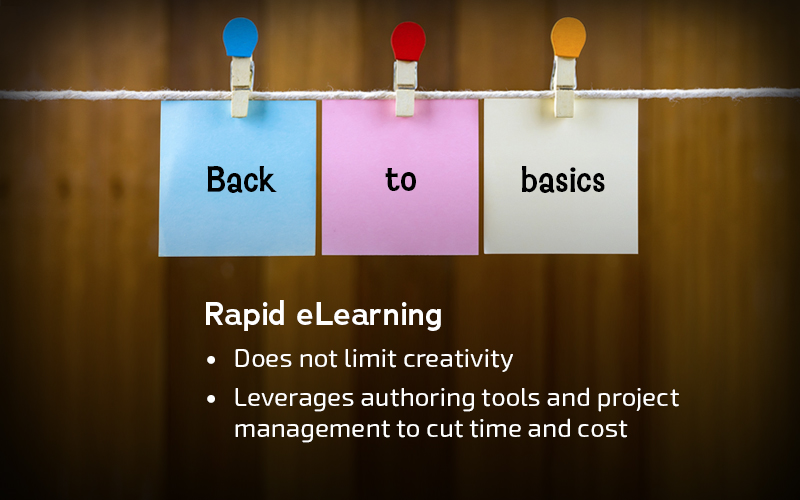6 Instructional Design Strategies to Boost the Quality of Rapid eLearning Courses

Rapid eLearning accelerates the pace of eLearning development but while doing so, it makes sure the quality of courses is not compromised, but how? It utilizes the advanced quirks of authoring tools and follows new-age instructional design strategies to design interesting, engaging, and immersive rapid eLearning courses. Instructional design (ID) analyzes the training needs of the learners and helps the developers to come up with modern strategies to create systematic eLearning courses that enhance the learning experience and knowledge retention. This blog highlights 6 modern ID strategies that can help organizations enhance the quality of their courses.
Are Your Rapid eLearning Courses Failing to Engage Modern Learners?
Try to incorporate these new-age instructional design strategies:
- Scenario-based learning
- Guided Learning
- Learning Through Exploration or Discovery (LEAD)
- Simulations
- Storytelling
- Gamification
6 Instructional Design Strategies to Enhance the Quality of Rapid eLearning Courses
1. Scenario-based learning
Scenario-based learning motivates the learners to understand how a real-life situation might play out in a risk-free environment. This risk-free environment can be digital, virtually immersive, role play, or anything that can properly display the desired situation. Learners are put in certain situations and the final outcome depends majorly on the decisions they take or the actions they perform. These types of immersive instructional design strategies can highly enhance the engagement of modern learners.
AI technologies like Machine Learning and Deep Learning (ML & DL) can also be used to decide the actions and reactions of NPCs (non-playable characters) in a particular scenario. So, when you are designing rapid eLearning courses for various training sessions such as sales training, compliance training, and soft skills training, scenarios can effectively enhance their engagement.
Explore the details of scenario-based learning through this webinar recording.
2. Guided Learning
Guided learning is similar to scenarios, but here a learner’s actions are influenced by the guide, mentor, or AI instructor. It’s not like they take the instructions for you, but they help you understand the basics and let you know whether your choice was right or wrong, then guide you toward the correct choice. Guided learning works best to train employees on how to use certain software’s user interface and its basic functioning, or how to complete a certain process such as sharing files in a public folder.
3. Learning Through Exploration or Discovery (LEAD)
Ever played a treasure hunt game or a closed-world exploration RPG? If yes, this is exactly the concept, but for learning or training. If not, let me explain the LEAD strategy in simple words, you are provided with a virtually explorable map and certain clickable icons, images, and other elements are added for interaction. Learners can explore the whole map at their own pace and are allowed free unrestricted navigation throughout the map. The best applications of this design strategy are employee onboarding, product training, and safety training.
4. Simulations
While scenarios have a more theoretical approach toward training, simulations provide practical know-how to perform a task or understand a subject and its functioning. Learners are made to work in a risk-free sandbox environment and learn things by having a hands-free experience. One of the most important benefits of simulations is the unexplored potential due to the futuristic advancements in the field of AR and VR happening every now and then.
AR and VR technology can be creatively integrated with rapid eLearning authoring tools to incorporate immersive simulations within the eLearning courses and provide an immersive learning experience to the learners. Most of the software training, machinery training, and medical training is carried out with the help of simulation-based rapid eLearning courses.
5. Storytelling
Ever since our childhood, stories are one of the most influential means of our entertainment, as they used to keep us hooked till the end. Storytelling can help the eLearning developers design rapid eLearning courses that can connect emotionally with the learners and provide a sticky learning experience. It helps the learners achieve their desired training goals and retain the information they gain for a longer period of time.
The best part about storytelling is that it can be used for almost all types of training like employee onboarding, performance support, etc. To provide a formal eLearning experience, storytelling is incorporated within case studies whereas comic strips work well for informal eLearning.
6. Gamification
The biggest benefit of game elements like badges, points, awards, levels, and leaderboards is that they immensely boost the engagement of courses, due to enhanced feeling of motivation and competition a game promotes. Gamification has been a buzzword lately because organizations have started to understand the importance of various game elements to transform their rapid eLearning courses. Even modern rapid eLearning authoring tools come with various options to gamify courses and their assessments. IT training, marketing training, management training, and product training are some of the preferred use cases of gamified rapid eLearning courses.
While gamification incorporates game elements in an eLearning environment, game-based learning facilitates training with the help of actual games. For example, dr. driving is one of the famous games that was advised by some driving schools to help learners understand the basics of driving. Games have this tendency to promote social learning and provide instant feedback to the users, and this helps organizations to promote edutainment as a crucial part of their learning experience.
Parting Thoughts!
Instructional design work as a skeleton for rapid eLearning courses, where the learning objectives and training needs are aligned together to come up with the desired strategy to enhance employee engagement. To incorporate a successful instructional design, you need to understand how to effectively utilize the power of rapid authoring tools. There are a lot of modern rapid eLearning authoring tools that can effectively incorporate these strategies and this eBook will help you choose the right authoring tool to create engaging eLearning courses quickly and efficiently.





